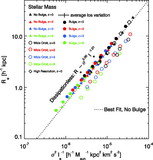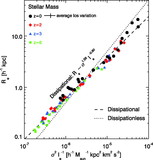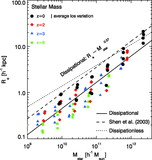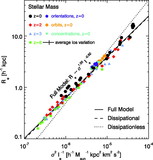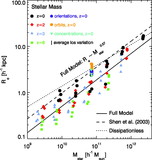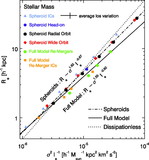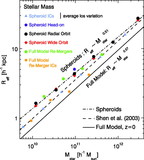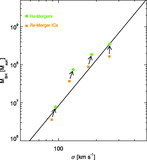Image Details

Caption: Fig. 11.
ReM![]() relation produced by the merging of gas‐rich disk galaxies with dark matter halos, star formation and supernova feedback as a function of progenitor gas content. The galaxy models are appropriate for ﹩z=0﹩ and are merged on nearly radial, parabolic orbits. Shown are remnants produced by progenitor systems with gas fraction ﹩f_{\mathrm{gas}\,}=0.01﹩ (red squares and line), ﹩f_{\mathrm{gas}\,}=0.025﹩ (yellow triangles and line), ﹩f_{\mathrm{gas}\,}=0.04﹩ (green diamonds and line), ﹩f_{\mathrm{gas}\,}=0.1﹩ (blue triangles and line), ﹩f_{\mathrm{gas}\,}=0.2﹩ (purple hexagons and line), and ﹩f_{\mathrm{gas}\,}=0.4﹩ (black circles and line). As the gas fraction of the progenitor systems increases, the dissipational effects of gas cooling and star formation produce smaller remnant effective radii and a corresponding change in the central stellar mass fraction (see also Figs. 10, 14, and 15). These dissipational effects generate a substantial tilt in the fundamental plane above a gas fraction of roughly ﹩f_{\mathrm{gas}\,}> 30\% ﹩.
relation produced by the merging of gas‐rich disk galaxies with dark matter halos, star formation and supernova feedback as a function of progenitor gas content. The galaxy models are appropriate for ﹩z=0﹩ and are merged on nearly radial, parabolic orbits. Shown are remnants produced by progenitor systems with gas fraction ﹩f_{\mathrm{gas}\,}=0.01﹩ (red squares and line), ﹩f_{\mathrm{gas}\,}=0.025﹩ (yellow triangles and line), ﹩f_{\mathrm{gas}\,}=0.04﹩ (green diamonds and line), ﹩f_{\mathrm{gas}\,}=0.1﹩ (blue triangles and line), ﹩f_{\mathrm{gas}\,}=0.2﹩ (purple hexagons and line), and ﹩f_{\mathrm{gas}\,}=0.4﹩ (black circles and line). As the gas fraction of the progenitor systems increases, the dissipational effects of gas cooling and star formation produce smaller remnant effective radii and a corresponding change in the central stellar mass fraction (see also Figs. 10, 14, and 15). These dissipational effects generate a substantial tilt in the fundamental plane above a gas fraction of roughly ﹩f_{\mathrm{gas}\,}> 30\% ﹩.
Copyright and Terms & Conditions
© 2006. The American Astronomical Society. All rights reserved. Printed in U.S.A.


